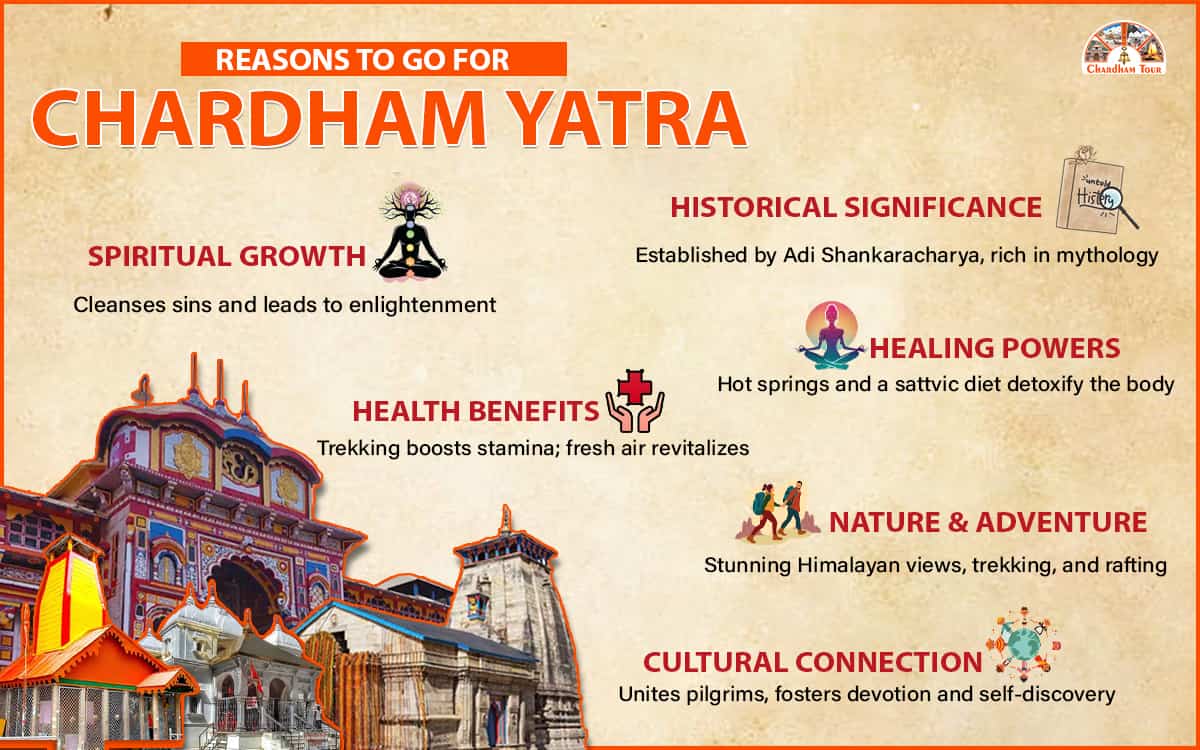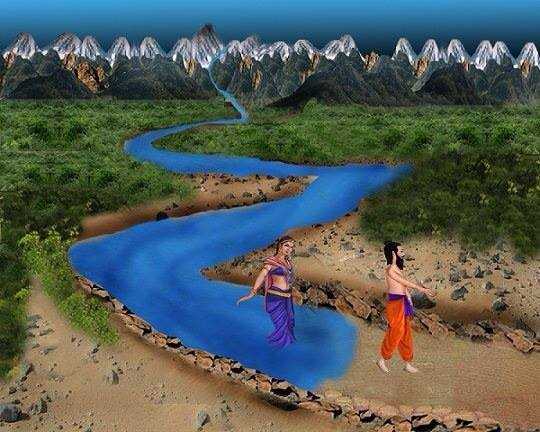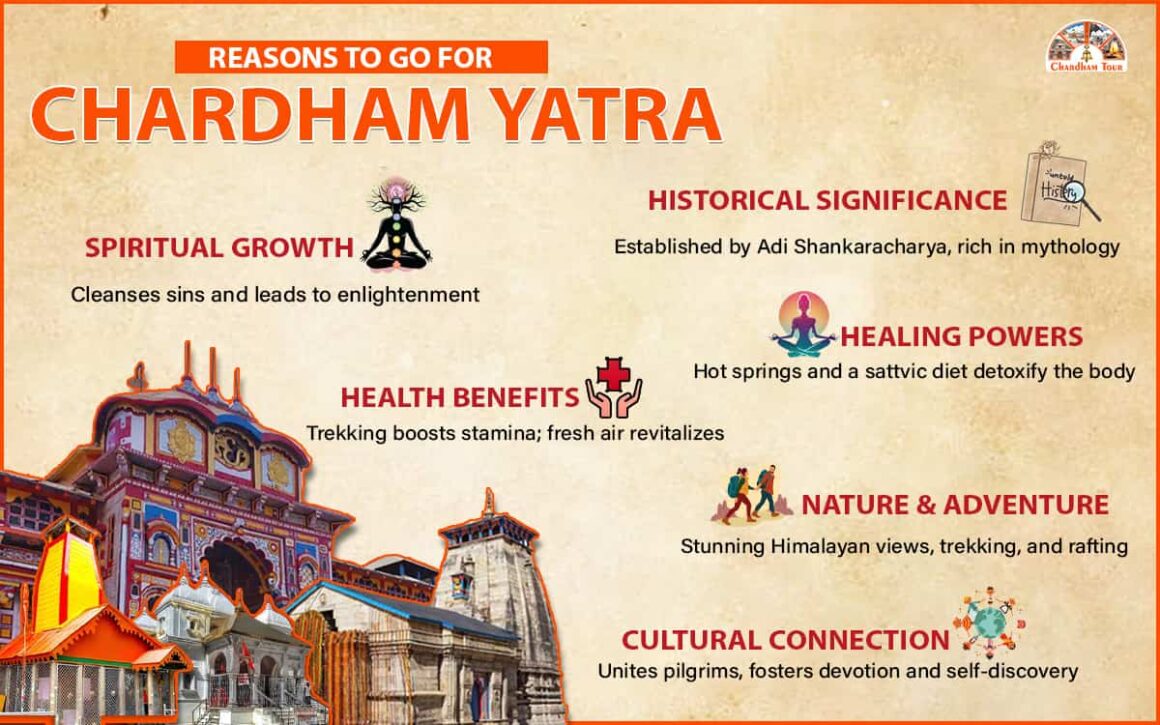The call of the divine is an irresistible call which pulls men from far and wide to the Daivya Bhoomi of Uttarakhand. Withstanding all hardships of the perilous path, thousands of pilgrims trek to the holy Chardhams every year. Read on to learn what all pulls them to that sacred pilgrimage destination.
All devout Hindus nurture a dream to partake in the haloed Chardham Yatra at least once in their life-time. This annual pilgrimage to the high mountains holds a great significance for the devotees. This Chardham encapsule the four holy sites namely Yamunotri, Gangotri, Kedarnath and Badrinath. It is called Chota Chardham as all the sites are within the state of Uttaranchal and quite close to each other. Before we delve into the various reasons, let us first get to know the basics of the Chardham Yatra.
 What is Chardham?
What is Chardham?
‘Char’ means four and ‘Dham’ means abode of God, ‘Chardham’ therefore means the ‘Four Holy Abodes of God’. These holy destinations are Yamunotri and Gangotri in Uttarkashi district, Kedarnath in Rudraprayag district and Badrinath in Chamoli district of Uttaranchal. Yamunotri is at an elevation of 3291 m (10,797 ft), Gangotri at 3048 m, Kedarnath being the highest at 3583 m (11755 ft) and Badrinath at 3133 m (10,279 ft). All the four sites are in the Garhwal region of the Himalayas. The Yatra follows a route from west to east direction, i.e, clock-wise direction starting from Yamunotri and proceeding towards Gangotri then Kedarnath. The termination of yatra is at Badrinath. It is believed that Adi Shankaracharya was freed from the cycle of birth and death and attained salvation at Badrinath. This Yatra also therefore, metaphorically indicates our journey towards salvation through the difficulties of life.
Significance of Chardham Yatra:
Every devout Hindu considers it as a religious duty to embark on the pilgrimage of Chardham. It is believed to wash away sins of not only of this birth but of previous births too. The ancestors too find happiness and higher position due to the religious duty performed by their descendants.
Interesting Facts About Chardham:
Yamunotri: Mythologically, Yamuna is the daughter of Kalind (Sun God) and Sangya (consciousness), and is also named as Kalindi (daughter of Kalind). Yama is Yamuna’s elder brother. Myth has it that Yama promised his sister Yamuna that whoever takes a holy dip in Yamuna on Bhai Dooj will never be carried to Yamalok.

Gangotri: In mythology Ganga is said to reside in the pot of Brahma and at the feet of Vishnu. Following Raja Bhairath’s penance and prayer for thousands of years for the salvation of his sinning ancestors, Ganga descended on the Earth at Gangotri. Since, earth was incapable to tolerate the huge force of Ganga, Shiva opened his matted locks and Ganga descended on his head. From Gaumukh (the Glacier) she found her way through the winding path of the Himalayas, the Plains and finally meeting the sea at Gangasagar in Bay of Bengal.
Kedarnath: Kedarnath has found his name from the King of Satyug, Kedar. The lord of Kedar is Kedarnath. The present Kedarnath temple is built by Adi Shankaracharya at around 800 AD according to Garhwal Vikas Nigam. The scientists are of the opinion that it was covered under snow for 400 years from 13th to 17th AD. Still, the temple is hard enough to endure the difficult weather conditions and it even tolerated the recent deluge in Uttarakhand. It is believed that Pandavas built a temple earlier at this place but it could not stand against Time.
Badrinath: There is an interesting fact regarding Badrinath. It is believed that there is a very powerful Bhairavi Yantra that effuses out powerful radiations all around. This is the reason that whoever comes here feels a calmness of mind. During the snowfall, when the temple closes down, the regular Puja is said to be done by Narad Muni evident for the fact that the lamp filled with clarified butter (ghee) that was left in the temple by the priests is seen to be still burning even after six long months. It is also believed that in near future Badrinath will be out of reach of the common mass and will be cut off from the world through a devastating landslide. Then, Badrinath will be worshipped at Bhavishya Badri which is at a lower elevation of 2,744 m about 17 km from Joshimath towards Lata.
Best Time to Visit Chardham:
The best time to embark on the Chardham Yatra is from May to October excluding the monsoons in July-September. Gangotri and Yamunotri open its portal on Akshaya Tritiya, Badrinath on Basant Panchami and Kedarnath on Maha Shiv Ratri. The holy shrine of Gangotri closes on Deepavali, Yamunotri closes two days after Deepavali on Yama Dwitiya (Bhai Dooj) and Badrinath closes on Vijaya Dashami and Kedarnath on Kartik Poornima. All the dates are fixed according to the traditional almanac and is decided by the priests of the temple governing committee of each shrine.
From November to April, the shrines remain under snow as these temples are situated at the higher reaches of Himalayas. During this time, not a single living soul resides there. But, stories float around that powerful hermits stay without any food and water all the year round in the caves meditating the Lord. It is believed that only the fortunate can see them and get their spiritual guidance.
Are you deciding to start off the pilgrimage to the sacred Chardham? Here are all the reasons that you must!
Historical Reason:

Adi Guru Shakaracharya’s name is held with great reverence amongst the Hindus. Not only was he the most respected theologician and philosopher, having written numerous Sanskrit verses and having consolidated Advaita Vedanta, he is most remembered amongst the common mass to have revived Hinduism. He had established many pilgrimage sites including the Chardham pilgrimage circuit. There are numerous stories attached with the discovery of each of the shrine which even now float as folklores in the hilly winds. Therefore, to visit Chardham is like looking back to our glorious past when India was treated as the Guru for her infinite wealth of knowledge.
Spiritual Reasons
The primary reason to visit Chardham for the devout is for the most obvious- spiritual upliftment. Every Hindu who has visited these four sacred spots feels a divine connection from within. The inner peace and contentment the pilgrims feel is unexplainable in mere words. It is believed that unless the higher power attracts the soul, no one can put a single toe on this land of Gods. Embarking on a journey for Chardham is like fulfilling a religious duty. Pilgrims believe that visiting these holy places not only washes away all the sins accumulated through numerous births and rebirths but also prepares one’s soul for the journey towards ‘Enlightenment’.
Scientific Reasons
There are many scientific reasons to embark on this journey too putting aside the spiritual reasons. The difficult trek challenges one out of his comfort zone. Climbing up mountains needs discipline and stamina. Mountain is a very strict teacher in that sense. The undisciplined will not be able to reach his destiny. Every day, one has to follow a strict schedule whether one goes solo or with a travel company. Therefore, through the pilgrimage one can check one’s physical stamina and will power. Moreover, the fresh air revitalizes us to great extent. The trekking is tough but the winding hilly path through serene hilly woods and rivers makes one feel oneness with nature. The beautiful scenery itself is a reason to embark on this journey and relish the beauty of the mountains.
Medical Reasons
Sedentary lifestyle is a bane in today’s world which has given rise to numerous medical complications. Trekking through the mountains has many medical benefits. First of all, the tough trek toughens the muscles and bones as well as the heart muscles. It is also puts challenge to one’s will power. There are many who are physically challenged and completes the Chardham yatra by sheer mental stamina and will power. This is indeed is a fulfilling journey. The pure oxygen wafting through the hills is rejuvenating. Filling your lungs with the fresh air fills you up with all the energy needs to complete the journey. During the journey, it is prohibited to take non-vegetarian food and alcohol drinks. Therefore, the plain food habit flushes out the toxins and restores the pink of health. Also, taking holy dip in the thermal water tanks has many medicinal advantages. The hot springs are full of many life saving minerals and bathing in it cures many chronic illness. The doctors also subscribe to the therapeutic values of the hot water spouts. Last but not the least, the absolute tranquility of the snowy mountains has a meditative ambience which relieves you of the constant meaningless chattering of the mind within. The chanting of mantras and the ringing of the bell echoing through the mountains too help in embalming the torn and shattered soul in the maddening crowd and complexities of the urban life.
Connecting with the Real India
This Yatra is not only a pilgrimage. The Hindu philosophy emphasizes and believes in the collective spiritual growth. Therefore, it also connects you to the fellow Indians from all the corners of the world. There are the wealthy people who felt the need to reconnect with the spirit within, there are penniless who embarks on this journey in the belief of washing away all the bad karma. The love and devotion connects these pilgrims together embarking on the journey towards the Light. Walking together with the soul-brothers, you get to know their stories, their difficulties and their happiness. This sharing of minds creates a strong bond between the pilgrims lasting sometimes for a lifetime.
Rediscovery of Self
In the path to discovering the unknown India, you rediscover yourself in the process. We seem to lose ourselves in the tide of the urban complicacies; everything revolves around ‘I, Me and Myself’ which is charged more by the present consumerist culture. In the way, we become self-centered and myopic to the vast world outside. Embarking on this spiritual journey is to reconnect with one’s own self. The self-discovery leads to your real emotional and spiritual needs. The pilgrimage leads to new challenges and paths and each unfolds a new trait of you. You get to know your abilities and now you can challenge the limits that bound you. An all-round development: physical, mental and spiritual, is guaranteed in this Yatra. Recharge your soul through this pilgrimage.
Adventurers and Nature Lovers
Those who are more interested in the natural beauty and the challenging treks can find Chardham Yatra equally rewarding. The tranquil atmosphere, the indescribable pristine Himalayan splendor is a wealth in itself in the eyes of the pilgrims and the nature lovers alike. The difficult terrains boost the adrenalin level of the trekkers, hikers and adventure seekers. If you are not into the whirlwind pilgrimage journey but like to relish each and every moment spent in the lap of Himalayas, you should consider the various adventure sports available at these spots and nearby areas like trekking, rock-climbing, mountaineering and different water sports.
Every Hindu should visit Chardham every year to break away from the monotonous and mundane routine of daily life and get a fresh leash of life. A Yatra each year will rejuvenate one physically, mentally and spiritually lasting for a year. It will help one reconnect with one’s own inner self when we feel lost in the intricate maze of life. In a way, we can say that the Chardham yatra is metaphorical of our life journey: we pass thorough the ragged hilly terrains symbolizing the difficulties and challenges of life to meet our dear God, the final destination of Life, the only reason for our existence on this beautiful Earth.



 Call
Call WhatsApp
WhatsApp Enquiry
Enquiry




Leave a Reply